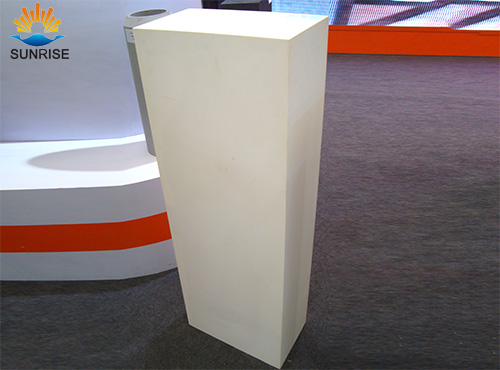How To Improve The Properties Of Corundum Blocks
Date:2016-06-15 19:54 From:Zhengzhou Sunrise Refractory Author:admin
The properties of corundum block refer to its properties at high temperature, including refractoriness, softening temperature unde load, reheating linear change, thermal shock resistance, slag resistance, acid resistance, alkali resistance, oxidation resistance, hydration resistance and corrosion resistance to CO.

To improve the properties of corundum block, many aspects should be taken into consideration, including its features and operation conditions.
(1) Improve refractoriness
Refractoriness refers to the temperature at which the material softens. It indicates the ability of the corundum block to resist high temperature without deformation. Only if the refractoriness of Inorganic non metallic materials up to 1500℃ can be called refractory material. Refractoriness is different from the melting point. It should not be regarded as the working temperature of corundum block. The influential factors for refractoriness include its chemical compostion and impurities, especially those which have a strong role in flux and can seriously reduce the refractoriness of corundum block.
(2) Improve softening temperature under load
Softening temperature under load is a measure of the deformation behavior of refractory ceramic products subjected to a constant load and increasing temperature. It indicates the ability of corundum block to resist high temperature an load and, to a certain extent, indicates the structural strength of the brick under the similar conditions. The influential factors for softening temperature under load include its chemical compostion and micro-structure. Improving the purity of raw materials, reducing the content of low-melting-point subtances or flux, increasing the molding pressure and increasing the density can significantly increase the softening temperature under load.
(3) Control the reheating linear change rate
Reheating linear change rate is the residual expansion or contraction of its length when reheated to a predetermined temperature and cooled to room temperature after a certain time of temperature preservation. Positive sign "+" indicates expansion and negative sign "-" indicates contraction. It is one of important indicators for the quality of refractory bricks. The reheating linear change rate of products with the same chemical compostion may be different since some may be not sufficiently fired due to temperature variations and lack of time. These products may be expanded or contracted due to physical or chemical changes when subjected to high temperature in the long-term use. This change makes great harm to the furnace, so it is very necessary to control the firing process well to make the indicator within the standard or smaller.
(4) Improve the thermal shock resistance
Thermal shock resistance refers to the ability of corundum block to resist sharp temperature changes. It is also called thermal stability, resistance to rapid temperature variability or resistance to thermal shock. During the use, corundum block is constantly subjected to sharp temperature changes, which is one of the main reasons for the damage of furnaces. The main influential factor for the thermal shock resistance is its physical properties(thermal expansion, thermal conductivity, etc.). In general, the bigger the thermal expansion rate of corundum block, the poorer its thermal shock resistance; the higher the thermal conductivity, the better its thermal shock resistance. In addition, the structure, particle compostion and shape will also affect the thermal shock resistance of corundum block.
(5) Improve slag resistance
Slag resistance refers to the ability of corundum block to resist slags and scouring action. The slag corrosion is one of the common damages during use. The slag resistance of corundum block is mainly related to the chemical compostion and structure as well as the properties of molten slags. One of effective ways to improve the slag resistance is to improve its purity and chemical compostion and reduce its low-melting-point substances and impurities to improve the reaction temperature of liquid phase and the outside.
